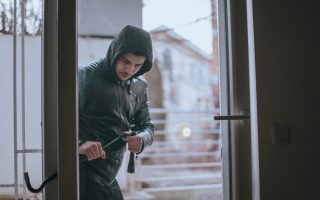
When you think about home security, your mind probably goes to alarm systems, deadbolts, and security cameras. Those are all important, but what if the biggest deterrents are things you’ve never even considered? Burglars are creatures of habit and efficiency. They want the easiest target with the lowest risk of getting caught. Sometimes, the things that make them walk away have very little to do with high-tech gadgets.
Security experts and even former burglars have revealed some of the stranger, less obvious reasons a house gets a pass. Here are seven odd reasons burglars might skip your house.
1. You Have a Dog—Even a Small One
You might think a tiny chihuahua is useless as a guard dog, but you’d be wrong. Burglars aren’t necessarily afraid of being attacked; they are afraid of noise. Even a small dog’s frantic barking is enough to draw unwanted attention from neighbors. It’s an unpredictable element they can’t control.
A loud dog eliminates the element of surprise. It creates a scene and increases the risk of being seen. Many burglars would rather move on to a quieter, pet-free home than deal with the hassle and noise of a yapping dog, no matter its size.
2. Your Landscaping Is a Mess
That overgrown, thorny rose bush under your window might be an eyesore to you, but to a burglar, it’s a painful obstacle. Manicured lawns and sparse landscaping can offer clear, easy paths to windows and doors. Messy, dense, or prickly bushes make access difficult and noisy.
Similarly, a yard full of clutter, like kids’ toys or gardening tools, can be a deterrent. It’s noisy to navigate in the dark and suggests that the homeowners are active and possibly at home. Sometimes, a little bit of strategic, “hostile” landscaping is more effective than a security sign.
3. You Have a Nosy Neighbor
One of the biggest deterrents for a burglar is the feeling of being watched. A neighborhood with active, observant neighbors is a nightmare for them. If you have a neighbor who is always outside gardening, walking their dog, or peering through their blinds, you have a free, highly effective security system.
Burglars often watch a neighborhood to learn its rhythms. If they see that a neighbor is consistently aware of their surroundings, they know their chances of being noticed and reported are high. A strong community watch, even an unofficial one, is a powerful weapon.
4. Your House Looks… Complicated
Burglars want to get in and out as quickly as possible. A house with a simple, predictable layout is ideal. A home with a strange design, multiple levels, or confusing entry points can be a turn-off. It’s harder to navigate quickly, especially if they are unfamiliar with the space.
Unusual architectural features or a quirky floor plan can create uncertainty. They don’t know where the valuable items might be or what obstacles they might encounter. This unpredictability increases the time they need to spend inside, which in turn increases their risk. Sometimes, being a little weird is a good thing.
5. There’s a Car in the Driveway
This seems obvious, but its importance can’t be overstated. The vast majority of home break-ins happen during the day when people are at work or school. The presence of a car in the driveway is the strongest and simplest sign that someone might be home. It’s a gamble most burglars are unwilling to take.
Even if you’re not home, leaving a second car in the driveway can be a powerful deterrent. It creates doubt, and doubt is a burglar’s enemy. They would much rather hit a house where they are certain no one is present.
6. You Leave the Television or Radio On
Silence is a green light for a burglar. Sound, on the other hand, creates uncertainty. Leaving a TV or radio on when you leave the house mimics the sounds of someone being home. From the outside, the muffled sound of voices or music is often indistinguishable from actual conversation.
This simple trick costs almost nothing but can be highly effective. It suggests activity and presence. For a burglar trying to make a quick, risk-free score, the possibility of walking in on someone is enough to make them move on to the next, quieter target.
7. Your Mailbox Is Empty
An overflowing mailbox or a pile of newspapers on the porch is a classic sign that no one is home. It’s like a giant advertisement that says, “This house is empty!” Taking a few seconds to bring in your mail and newspapers each day removes that signal.
When you go on vacation, have a trusted neighbor or friend collect your mail. This maintains the appearance that the house is occupied. It’s a small, mundane task, but it’s a crucial part of making your home look lived-in and secure. A burglar looking for an easy target will notice the empty mailbox and likely assume someone is home.
Security Is About Perception
Ultimately, home security is about creating the perception of risk. You want to make your home look like more trouble than it’s worth. While alarm systems and cameras are great, don’t underestimate the power of these simple, and sometimes strange, deterrents. By making your home seem active, unpredictable, and a little inconvenient, you can convince a potential burglar to just keep walking.
What’s a simple security trick you use to protect your home? Share your tip in the comments below!
What to Read Next…
- 6 Innocent Household Items Burglars Always Look For First (And Why You Should Hide Them)
- 7 Creepy Home Break-In Tactics Burglars Swear By
- 10 Safety Tricks Burglars Don’t Want You to Know
- 8 Odd Places Criminals Hide Before Breaking Into Houses
- 8 Ways Your Amazon Alexa Could Be Helping Criminals Hack Your Life

Latrice is a dedicated professional with a rich background in social work, complemented by an Associate Degree in the field. Her journey has been uniquely shaped by the rewarding experience of being a stay-at-home mom to her two children, aged 13 and 5. This role has not only been a testament to her commitment to family but has also provided her with invaluable life lessons and insights.
As a mother, Latrice has embraced the opportunity to educate her children on essential life skills, with a special focus on financial literacy, the nuances of life, and the importance of inner peace.







